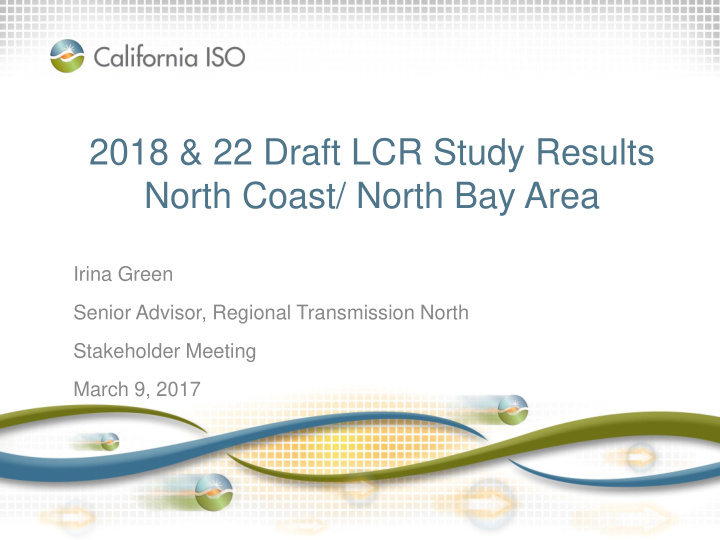



2018 & 22 Draft LCR Study Results North Coast/ North Bay Area Irina Green Senior Advisor, Regional Transmission North Stakeholder Meeting March 9, 2017
Humboldt and North Coast/North Bay Areas Slide 2
North Coast/North Bay Load and Resources (MW) 2022 2018 1371 Load = 1407 -50 AAEE = -27 -103 Behind the meter DG = -79 31 Transmission Losses = 32 1249 Total Load = 1333 721 Market Generation = 721 0 Wind Generation = 0 114 Muni Generation = 114 15 QF Generation = 15 850 Total Qualifying Capacity = 850 Slide 3
North Coast and North Bay Slide 4
Eagle Rock Sub-Area Eagle Rock Sub-area – Single Contingency Contingency: Cortina-Mendocino 115 kV line, with Geyser #11 unit out 2018 LCR need: 191 MW (includes 3 MW of QF/Muni generation) 2022 LCR need: 215 MW (includes 3 MW of QF/Muni generation) Limiting component: Thermal overload on Eagle Rock-Cortina 115 kV line Eagle Rock Sub-area – Double Contingency Contingency: Cortina-Mendocino and Geysers #3-Geysers #5 115 kV lines 2018 LCR need: 209 MW (includes 3 MW of QF/Muni generation) 2022 LCR need: 233 MW (includes 3 MW of QF/Muni generation) Limiting component: Thermal overload on Eagle Rock-Cortina 115 kV line Slide 5
Eagle Rock Sub-Area Largest single unit in the pocket Radial line connecting two units Slide 6
Fulton Sub-area Fulton Sub-area – Single Contingency No requirement Fulton Sub-area – Double Contingency Contingency: Fulton-Lakeville and Fulton-Ignacio 230 kV lines Limiting component: Thermal overload on Lakeville# 2 60 kV line (Lakeville-Petaluma-Cotati 60 kV), which was previously normally opened at Cotati Substation 2018 LCR need: 430 MW (includes 14 MW of QF and 56 MW Muni generation) 2022 LCR need: 411 MW (includes 14 MW of QF and 56 MW Muni generation) If the Lakeville # 2 60 kV line is open, then the limiting element is Santa Rosa-Corona 115 kV line, and there is no additional LCR need compared with the Eagle Rock sub-area Slide 7
Fulton Sub-area Slide 8
Lakeville Sub-area Lakeville Sub-area (NCNB Overall) – Category B Contingency: Vaca Dixon-Tulucay 230 kV line with Delta Energy Center power plant out of service Limiting component: Thermal overload on the Vaca Dixon-Lakeville 230 kV line Ames/Pittsburg Sub-area – Category C Contingency: DCTL Newark-Ravenswood & Tesla-Ravenswood 230 kV Limiting component: Thermal overload on the Newark-Ames #2 115 kV line 2018 LCR need: NCNB: 634 MW (includes 14 MW of QF and 115 MW Muni generation) Ames: 596 MW (includes 0 MW of QF and Muni generation) Pittsburg: 1182 MW (includes 200 MW of QF and Muni generation) Slide 9
Lakeville Sub-area NCNB Sub-area – Category B Contingency: Vaca Dixon-Tulucay 230 kV line with Delta Energy Center power plant out of service Limiting component: Thermal overload on the Vaca Dixon-Lakeville 230 kV line Ames/Pittsburg Sub-area – Category C Contingency: DCTL Newark-Ravenswood & Tesla-Ravenswood 230 kV Limiting component: Thermal overload on the Newark-Ames #2 115 kV line 2022 LCR need – Vaca Dixon-Lakeville 230 kV lines not reconductored: NCNB: 628 MW (includes 14 MW of QF and 115 MW Muni generation) Ames: 596 MW (includes 0 MW of QF and Muni generation) Pittsburg: 1162 MW (includes 200 MW of QF and Muni generation) Slide 10
Lakeville Sub-area NCNB Sub-area – Category C Contingency: Vaca Dixon-Tulucay and Vaca Dixon-Lakeville 230 kV lines Limiting component: Thermal overload on the Moraga-Sobrante 115 kV line Ames/Pittsburg Sub-area – Category C Contingency: DCTL Newark-Ravenswood & Tesla-Ravenswood 230 kV Limiting component: Thermal overload on the Newark-Ames #2 115 kV line 2022 LCR need – Vaca Dixon-Lakeville 230 kV lines reconductored: NCNB: 440 MW (includes 14 MW of QF and 115 MW Muni generation) Ames: 596 MW (includes 0 MW of QF and Muni generation) Pittsburg: 1232 MW (includes 200 MW of QF and Muni generation) Slide 11
Lakeville sub-area one line and generator OVERLOAD OUTAGE LCR need depends on the generation in the Pittsburg area. Slide 12
Lakeville Sub-area double line outage LCR need depends on the generation in the Pittsburg area. Slide 13
Changes Since last year: 1) 2018 load forecast has increased by 22 MW vs. 2017 2) LCR need has decreased in 2018 vs. 2017 by 87 MW mainly due to load decrease in the Bay Area. 3) 2022 load forecast has decreased by 69 MW vs. 2021 4) LCR need has decreased in 2022 vs. 2021 by 40 MW mostly due to load decrease. Your comments and questions are welcomed For written comments, please send to: RegionalTransmission@caiso.com Slide 14
Recommend
More recommend